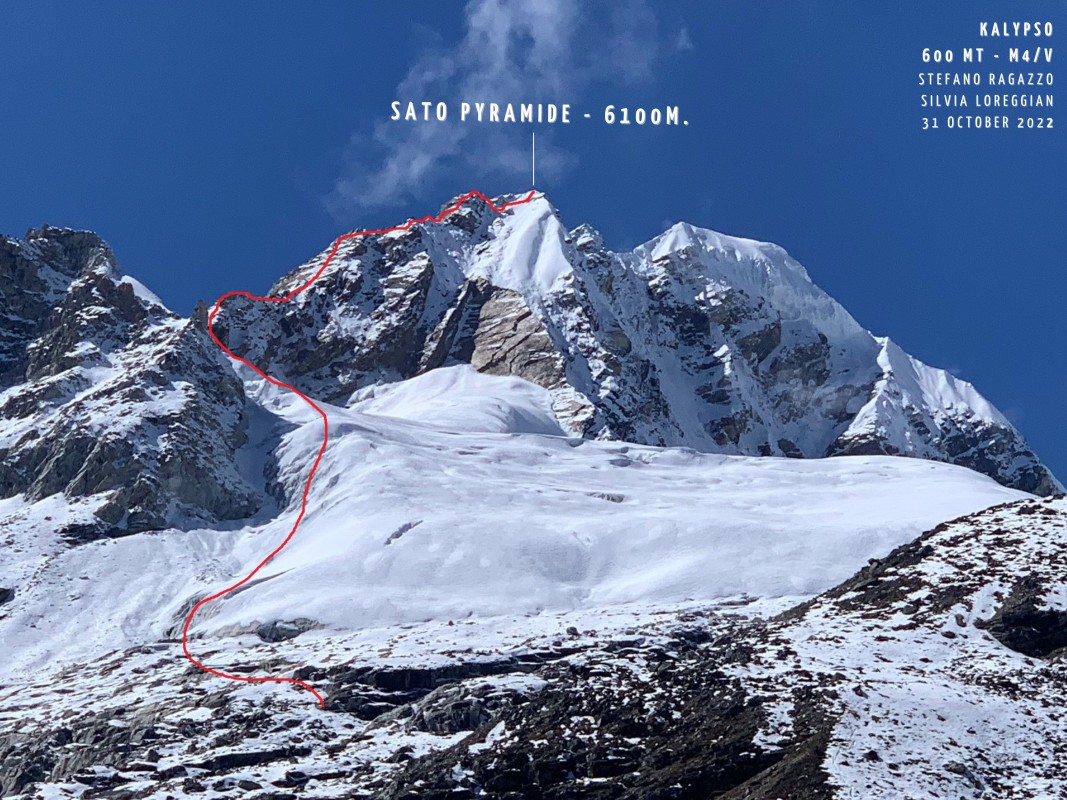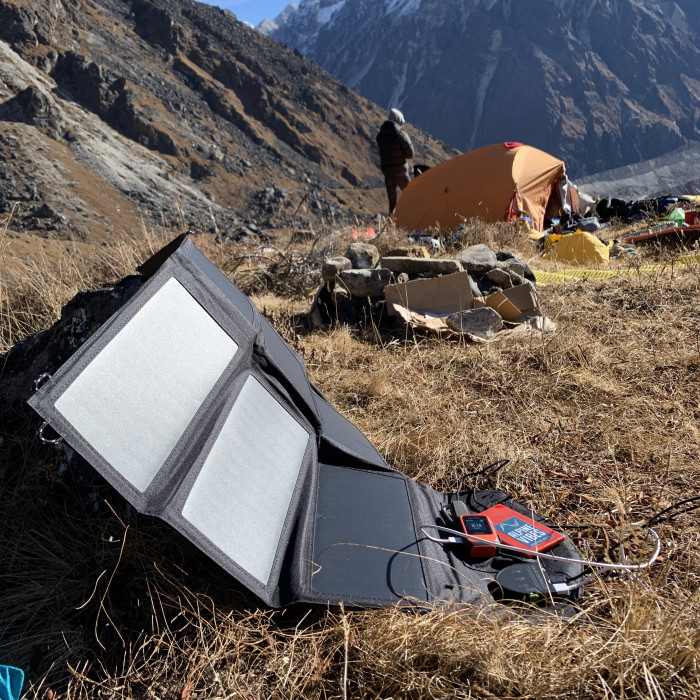_63a471596c48a.jpg)
Sato Pyramide: an unclimbed peak in the Himalaya for Silvia Loreggian and Stefano Ragazzo

Last October, the two mountaineering guides from Padua climbed a new route Alpine-style, to a virgin summit at 6,100 metres in the Kangchenjunga massif. Ferrino was at their side, providing them with high-altitude sleeping bags and tents.
Silvia Loreggian and Stefano Palazzo are two young mountaineering guides from Padua, who are partners in climbing as well as in life. After exploring the Alps far and wide from the Dolomites to Mont Blanc, and visiting legendary locations like Patagonia and Tierra del Fuego, their dream was to experience a great adventure in the wild mountains of the Himalaya.
This dream came true last October, when Silvia and Stefano completed the first climb along Kalypso, the new 600-metre route they blazed to the summit of Sato Pyramide, a 6,100-metre Nepalese summit in the Kangchenjunga massif that had never been conquered before.
“For us, the Himalaya was always a very special place, an entirely different dimension where you can still live a total adventure,” says Silvia. “It has immense mountains and valleys, where there is still room for discovery and exploration. We wanted to get a taste of it, trying to complete a beautiful climb on one of the many peaks there that are still waiting to be conquered, far from the most touristic and popular destinations.”
Silvia and Stefano’s search led them to focus on the Kangchenjunga National Park area, in Nepal, where the famous 8,586-metre colossus is surrounded by imposing 7,000-metre peaks like Jannu, where some of the most beautiful chapters in the history of high-altitude mountaineering have been written, and a forest of 6,000-metre peaks still waiting for their first climber.
“The valleys around Kangch immediately charmed us, because the area still attracts little hiking and mountaineering tourism. Initially we were aiming for Sharphu III, which is approximately 6,200 metres high. However, according to the Nepalese government’s database, the peak of Sharphu III is 6,800 – which would have blown the costs for climbing permits way over our budget. So we decided for Sato Peak, which is also 6,200 metres and has a beautiful north wall.”
At the heart of the Himalaya
The change of plans was not a setback at all, and the adventure Silvia and Stefano were looking for began as soon as they got closer: “To reach the base of the mountain, we had to climb up the little valley between the villages of Ghunsa and Kambachen, where nobody had set foot for many years,” Silvia continues. “Luckily, the local shepherd who helped us carry our equipment with his two yaks was one of the people who had ventured into the valley a while back. Thanks to him we were able to find the passage between the steep sides, where the yaks had to prove all of their ‘alpine’ abilities, and we found a pasture at 4,500 metres with a small water stream. That’s where we set up our basecamp. Once we said goodbye to our friend, the adventure we were seeking really began: we were alone, at the heart of the Himalaya, surrounded by countless peaks – the lowest still higher than the top of Mont Blanc. We had never felt such a sense of immensity, not even in Patagonia. It scared us a little: what would happen if we had any difficulties or if we needed to be rescued? Yet, above all, we were happy to be there!”
As in any proper adventure, there were many surprises and stumbling blocks: “We began acclimatisation by climbing up to the base of Sato Peak, where we set up an advanced camp at 5,300 metres. But we soon realised that the idea of climbing the north wall was not feasible. The line we had identified was a nice goulotte we intended to tackle using the piolet traction technique, but unfortunately there were no ice or hard-packed snow in sight: at every step we took, we sunk half a metre in the loose snow, with our crampons hitting the rock underneath. After a few attempts, we decided to give up and try a different itinerary.”
On the summit of Sato Pyramide
After a couple of days at the basecamp to regain their strength and regroup, Silvia and Stefano decided to try the climb along the southeast crest, which is rockier and therefore safer, considering the conditions of the mountain.
“On October 31 at half past four in the morning, we left the advanced camp and headed towards the crest,” Silvia recalls. “It was really cold and the thermometer read -20 °C, but we knew it would get better as soon as the sun came up from behind Jannu. After the difficult climb up the glacier, we were able to find an access point to the crest. We tried again to stay on the snowy north side, but the loose snow forced us back up to the ridge every time. We ascended between rotten and unstable rock segments and others that were more compact and steeper, with some technical and fun climbing passages. It took us six hours to reach Sato Peak’s anti-peak, which is slightly lower than the main summit and separated from it by a sharp ridge marked by seracs and cornices. The snow conditions, however, were still the same – so we decided to end our ascent on this nameless peak, which we christened Sato Pyramide.”
Returning to the valley was not easy either. The two mountaineers came down the same route and, trying to go around a butte they had climbed on the way up, they found themselves on the south side – on quite unstable terrain that meant they lost precious time in trying to get back to the ridge. As the evening approached and temperatures fell, they began to fear they’d have to bivouac for the night. Luckily, however, in the very last moments of daylight they were able to reach their advanced camp, where the safety of Ferrino’s tents and the warmth of the brand’s sleeping bags awaited.
“In the days right after the ascent we felt somewhat regretful for how things went,” Silvia concludes. “We had travelled all the way there with the idea we’d complete a beautiful climb with crampons and ice axes, and instead we ended up on a less-than-solid rocky crest. In addition, we had to give up on the main peak. As time went by, however, the joy for the extraordinary experience we had the privilege of living took over. We called our route Kalypso, like the nymph that seduced Ulysses and held him captive on her island. After all, we are prisoners of our own love for mountains and adventure too.”
Share this article
_63a4735b1915c.jpg)
_63a4735b68d22.jpg)
_63a473272fdd5.jpg)

_63a47326d5faf.jpg)